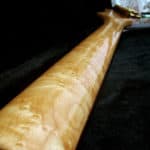As a guitar player, you may have faced that undesirable situation when a guitar doesn’t feel good.
At first, you might think that’s because you need some time to warm up and adjust to the instrument but as you continue playing, the more uncomfortable it feels.
Some players will blame the action, some others the distance between strings but let me tell you that, although those are possible alternatives, it usually occurs due to something different.
Perhaps is not what you expected but the neck size plays an important role on these occasions.
If you don’t feel comfortable strumming chords or playing scales on your guitar, it may be because your guitar neck is too thin for you. This is a common issue among players with big hands or fat and long fingers.
But don’t worry, here at GearAficionado we want to help you.
In this article, we are going to break up every concerning aspect of this topic so that, in the end, you will know everything needed to achieve the best solution.
Is it possible for a guitar neck to be too thin for your hands?
Every guitar model presents dissimilar characteristics but even those of the same one could have unalike neck profiles.
As a result, we can find equal guitars but with thicker or thinner necks.
For players with big hands is hard to play with a thin neck because they will need larger space to play properly.
Even wide fingers can be a pain in the neck when playing this neck profile because the lack of space between frets won’t let your fretting hand play freely.
However, that’s not always the case and musicians with long fingers find some techniques easier.
Therefore, a thin neck will be too thin only if you don’t feel comfortable playing it.
What to do if your guitar has a thin neck you don’t like?
As expected, not every guitar suits every musician, what is great for some guitarists might be awful for others, but what would be the reasons to say that?
Players with big hands usually find it difficult to fret a thin neck mainly because they feel discomfort, but also due to its playability and tone.
Luckily, you could do several things to improve those features. First, it is common, with certain guitar models, to replace the guitar neck with a thicker one.
If you have very big hands, a thick neck would be great because you will have more space to fret and to rest your hand as well.
Besides, a thicker neck would change the tone of your instrument.
Dense and larger pieces of wood have a tendency to spread the vibrations in a better way.
If you go for a thicker neck profile not only the tone but also the sustain will be improved.
Another alternative is simply getting a new guitar with a different neck shape or width.
Unfortunately, is not the cheapest option but the easiest plus most straightforward choice.
Finally, if are not able to afford either a brand-new neck or an entire guitar, what you can do is just adapt to the instrument.
Thin necks are tough to play for guitarists with wide fingers but getting used to them is not an impossible task.
For some players, the distance between strings plus the space available in the frets could be a pain in the neck but if you put in the hours you’ll get accustomed eventually.
It will for sure take time but not so much, through practice everything is achievable.
Can you get used to a guitar with a very thin neck?
As mentioned before, getting used to a thin neck takes time but is completely doable.
Whilst it is rather simple for guitar players with small hands, it is quite a challenge not only for those with big hands but also for rhythm guitarists because they are accustomed to more freedom on the fretboard.
To quickly get the hang of a thin neck, set out some practice sessions, noodle around, and try to unlock the whole fingerboard.
In that way, you will see an improvement in a short period of time.
Once you feel comfortable playing this type of neck profile, you will notice that you reach and cover larger sections just by stretching your fingers.
What is more, barre chords will be easier to fret because everything is nearer, running scales will be second nature and if you prefer using the thumb instead of playing barre chords will be a piece of cake.
Can you swap the neck of your guitar if you don’t like it?
Players who get through this typical situation sometimes try to adapt themselves to flush along with the instrument but loads of musicians believe that the instrument has to meet the player’s expectation and not the other way around.
If you find yourself in this particular situation, you could change your guitar neck with a new one.
This procedure is far easier when dealing with bolt-on necks.
When playing an instrument comfort is quintessential and this alternative may be the solution you were looking for.
Nonetheless, is not child’s play and you should bear in mind certain aspects.
As a rule of thumb, to replace a neck with another the two have to share both the neck pocket shape and the width.
In addition to that, the number of bolts in the neck joint must be the same.
Although those features are the most relevant, there are more issues to consider such as scale length, and neck hill among others.
If you are a Fender player and still feel curious about this topic here you have an article on Fender necks known to be interchangeable.
Can you modify a thin guitar neck to make it thicker?
Contrary to what you might think, a thin neck cannot be thickened.
Perhaps you heard that you can embed or attach materials to the neck but it won’t be a wise choice at all.
Although wood is a malleable material, there are no ways to enlarge or make it thicker. In those situations, it is suggested to swap the neck, as explained earlier.
However, if swapping the guitar neck is not your desired solution, what you can try is changing the fretboard.
Some musicians claim that a thicker fingerboard would make a thin neck feel wider.
Therefore, a thicker fretboard might be a choice but I wouldn’t say it is the best.
Anyway, try out every single alternative and choose the one that meets your own expectations.
Is it worth it modifying the neck of your guitar?
Reshaping or remodeling the neck of a guitar is more usual in thicker neck profiles, thin necks are not plenty of modifying alternatives and it is not recommended to reshape them.
Maybe, if your goal is making a subtle change is a good option but if you are looking for a radical change it’s not.
Having said that, the answer to this question will be strictly subjective due to the player’s preferences are always involved.
In most cases, a reshaped thick neck will be worth and sometimes better than a new one.
Nevertheless, you should know that is destructive work, meaning that you won’t be able to come back to the previous dimensions.
Moreover, necks are essential components in a guitar so any modification may influence the instrument’s performance being tone, and sustain the most affected features.

Hello there, my name is Ramiro and I’ve been playing guitar for almost 20 years. I’m obsessed with everything gear-related and I thought it might be worth sharing it. From guitars, pedals, amps, and synths to studio gear and production tips, I hope you find what I post here useful, and I’ll try my best to keep it entertaining also.





